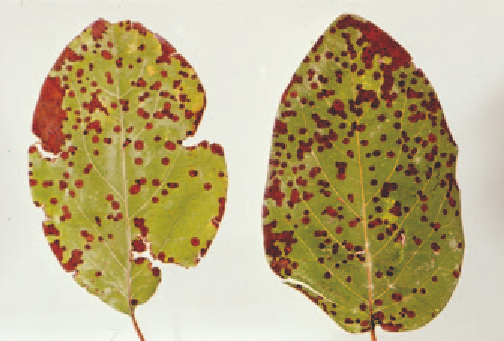Agriculture Reference
In-Depth Information
Maintain a balanced fertiliser and irrigation program.
•
Management
•
Prune out and destroy infected twigs and fruit
mummies during winter to reduce carryover of
inoculum.
Carefully remove and dispose of any brackets outside
of the orchard.
•
STEM-END ROT
■
Cause
The fungi
Fusicoccum
spp.
FABRAEA LEAF SPOT OR SCALD
OF PEAR
Cause
The fungus
Fabraea maculata
.
Symptoms
Both apple and pear are affected.
Symptoms
The disease is also called leaf blight and quince leaf spot.
Small, dark, circular, slightly raised spots develop on leaves,
increasing in size to about 5 mm and changing in colour to
tan and then black. Severely affected leaves turn yellow and
fall.
Infection results in a soft, brown rot of fruit and cankers
on fruiting twigs and young branches.
Source of infection and spread
Spores develop in fungal fruiting bodies in cankers, on
twigs and branches and on mummified fruitlets. The
spores are released during wet weather and spread by wind
and rain before harvest to infect fruit.
On fruit, small, reddish spots occur and gradually darken
to resemble those of black spot. Severe cracking may occur
on young fruit.
Importance
Moderate losses of fruit occur when wet conditions persist
near harvest. This disease is difficult to manage.
Fig 3.24 Fabraea scald on pear leaves visible as small, dark, circular
spots.
Fig 3.23 Stem-end rot appears as a soft brown rot at the stem end of
the fruit.
Fig 3.25 Symptoms of Fabraea scald on Williams pear fruit.













